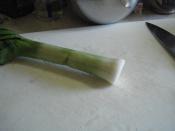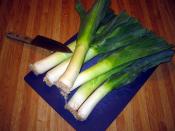Leeks, which are very predominant in Europe, have an exemplary history. Leeks date back to 4000 B.C., the Bronze Age, where many different inhabitants used to eat this vegetable for health purposes. Hippocrates, founder of the Hippocratic Oath, use to prescribe leeks as a cure for nosebleeds. As time progressed, armies and rulers spread the word about the wonders of the leeks. Emperor Nero ate leeks because he thought it was beneficial for his throat and vocal chords. He was later nicknamed "porrophagus" meaning leeks mouth. The Romans spread the popularity to Wales, as it became their national emblem. Leeks also have religious significance. They are mentioned in the Book of Numbers in the Bible as one of the beloved foods of the Israelis. Finally, the people to whom the leeks were made so popular to were the Welsh. The Welsh Prince Cadawallader made his soldiers wear leeks on their hats for identification.
Today the Welsh wear leeks to ceelbrate St. David's Day on March 1st.
As rich as the leeks are in their historical significance, they have many cultural uses- mainly as soups. Today, leeks are usually served as a scallion and are used to enhance soups and salads. This crunchy vegetable is rich in vitamin C, magnesium, and iron. Baby leeks consist of 75 calories and contain a great source of folate. Five daily servings can reduce cancer chances and blood pressure. The most famous serving of leeks is prepared by a chef at the Waldorf Astoria. The dish is known as the "Vichy." Finally, 'poor man's asparagus' as it is called in Britain, is wildly popular. Britain holds an annual leek competition, where the largest leek, four to five inches in diameter, is given as a prize.
Leeks are very valuable in the fall and...


